Capo |
Track |
Comments |
Year |
Tuning |
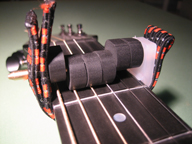 |
1- Suite in F:
For the Duchess- Part 1
(H. Reid) |
1-2-3– Suite in F: For the Duchess Standard tuning [CAPO: 0 2 2 2 0 0] The first serious piece for the Esus capo, it draws from the celtic and baroque music I was listening to in 1982. I recorded it on my 2nd LP in 1984 (with a 2nd capo which put it in F- hence the name), but did this version for my Solo Guitar Sketchbook CD. It is played here in E with a single capo. Part 3 is the hardest section, and one I really can’t do without fingerpicks. It uses the harp-like scales that become available in this configuration. This was written when the Third Hand was the only partial capo, so all 3 parts can be played with any Esus or universal partial capo. (f)(T1)[1989]) Buy the Transcription/TAB or Buy All 3 parts for $4.95 |
1988 |
Standard tuning |
 |
1- Suite in F:
For the Duchess- Part 2
(H. Reid) |
This part has some very nice moving bass lines, which are typical of the Esus configuration, unlike DADGAD tuning, which it resembles. Scales generally still lie within a 4 fret range, and it is possible to play flowing melodies in the treble with moving bass lines, with an open-tuning-like resonance. I have been hooked on this combination for years. [FIngerpicks] (1984 Taylor 810 cutaway) Buy the Transcription/TAB |
1988 |
Standard tuning |
 |
1- Suite in F:
For the Duchess- Part 3
(H. Reid) |
This is the hardest part of this suite, and one I really can’t do wihout fingerpicks. It takes of advantage of the harp-like scales that become available in this capo configuration. This suite was written and recorded back when the Third Hand was the only partial capo, so it does not use any notes behind or next to the capo. All 3 parts can be played with any Esus type partial capo. [FIngerpicks] (1984 Taylor 810 cutaway) Buy the Transcription/TAB |
1988 |
Standard tuning |
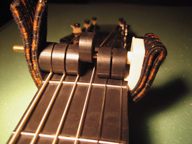 |
4- Für Elise
(L. Beethoven) |
Open Eb tuning [CAPO: 1 1 1 0 1 1] I took this note-for-note from a basic piano book, and did not have to change anything to fit the guitar. Other published arrangements of this all change or omit some notes. It’s nice to play Beethoven right. The E-minus effect is lovely to my ears, and one of the best and deepest configurations. [Bare finger] (1984 Taylor 810 cutaway) Buy the Transcription/TAB |
1989 |
Open Eb tuning
Eb Bb Eb G Bb Eb |
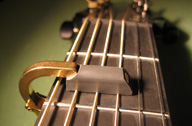 |
5-Arkansas Traveler
(Trad.) |
There are not many people who flatpick fiddle tunes solo, and the capo offers to my ears an additional and vital sustain and resonance. Once again, the scales are all standard tuning, and you’ll also notice it can be played in 2 octaves, which they usually don’t do in DADGAD. It’s nice to hear the medium-gauge strings tuned to full pitch, and this would be hard to flatpick with tone like this with thinner strings or if they were tuned lower. I do a “faux-dulcimer” part toward the end where the melody is played on the treble strings. [Flatpick] (1984 Taylor 810 cutaway) Buy the Transcription/TAB |
1992 |
Standard tuning |
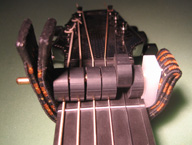 |
6- The Albatross
(H. Reid) |
I invented the “A-minus” tuning in January 1980, and this remains the only piece I have ever played in it. You tune the guitar to an open Ab chord, then capo to form an Am. Not long afterward I developed the “E-minus” which is similarly based on Open Eb tuning. An earlier recording of this was the first track on my first LP in 1982. It is a clever way to play minor-key slide by tuning the guitar to a major chord and then using the capo to make the open strings form a minor chord- in this case Am. [FIngerpicks] (1967 Mosrite Dobro round-neck) |
1989 |
Open Ab tuning
Eb Ab Eb Ab C Eb |
 |
7- Macallan’s Jig
(H. Reid) |
Probably the hardest of a dozen or so fingerpicked jigs I have written in Esus over the years. I write and recorded it the night before the mastering session for my Fruit on the Vine CD project. Playing fiddle tunes on the guitar has become a kind of macho guitar sport, and I can’t say it often enough that I think the Esus capo (and partial capo in general) is a very important tool for alowing guitarists to get the notes, chords, rhythmic drive, and ringing tone that this music likes. (Though it often ends up in E, not a fiddle key.) You pretty much treat the guitar like a banjo, which is generally fingerpicked in an open tuning. [FIngerpicks] (1984 Taylor 810 cutaway)Buy the Transcription/TAB |
1998 |
Standard tuning-1 |
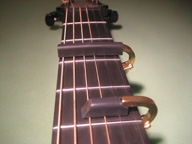 |
8- Norway Suite:
Part 3-
Farewell to Vikedal
(H. Reid) |
The first serious guitar piece in the Asus (A suspended) configuration. Oddly enough, I thought of the Asus in about 1981, about an hour before Esus, and never got around to using it in my repertoire until 1998. Because the B string is tuned up a half-step, it is pretty hard to get used to. The capo forms an A chord, but the tuning sharps the 3rd to a 4th, giving a lot of the same haunting drones, modal chords & flowing scales that Esus offers, but a musical 4th higher. [FIngerpicks] (2000 Larrivee C-10 cutaway) |
2000 |
E-A D-G-C-E
B string sharped to C
|
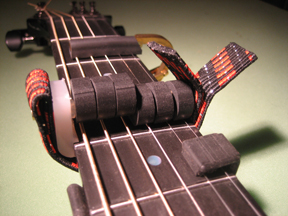 |
9- Wildwood Flower (Trad.) |
This somewhat convoluted 3-capo setup showed up on my first LP in 1982, and was an early attempt to make the guitar into a big dulcimer by imitating Open C tuning. (CGCGCE with a capo 4 is the same as this.) I was using pretty heavy strings and a Herco heavy flatpick, but still got some of the dulcimer vibe and stole some of its melodic technique on the high E string. I also cross-picked the melody in a lower octave, which is not dulcimer-like at all. I don’t think I ever performed this one, and just worked it up for the recording session. Back then I was just playing bars, and this isn't really barroom material. The version shown here uses a Shubb c8b and a modified Woodie;s G-Band Model 2, and in 1981 I did it with 3 Third Hands. Boy what a sight that was on the fingerboard. [Flatpick] (1975 Gallagher Doc Watson model) |
1981 |
Standard tuning |
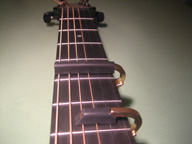 |
10- The Unknown Soldier (H. Reid) |
This is essentially what used to be called an “air,” and I often play it in unison with a fiddle. With the double capo it puts the melody pretty high up, and the overall effect is sort of like a small harp. Some of the scale passages are also played harp-style. I wrote this on the 6-string banjo, and recorded it for my Artistry of the 6-String Banjo CD, which is available on iTunes and many other digital download services. I like it on both guitar and banjo. [Bare finger] (1992 Larrivee L5-05) Buy the Transcription/TAB |
1993 |
Standard tuning |
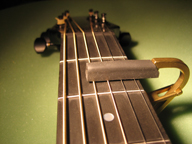 |
11- Johnson’s Blues (H. Reid) |
This is sneaky. If you tune the high E string down to D, then capo the “Half-Open A,” the guitar then sounds an open A chord. But when you put a slide across the top 4 strings it works just like a real open tuning. This piece is a small tribute to bluesman Robert Johnson, who used G and A tunings a lot and often played slide in them. The top 4 strings feel like an open tuning, but the bottom 5 play normally, so you can chord and play bass runs just like standard tuning. It’s a real quick way to get an open tuned Delta blues sound with a slide. (Early 1970's round-neck metal-body Dobro) [FIngerpicks] |
1994 |
E A D G B D (high E string dropped 2 frets) |
 |
12- Hard Times, Come Again No More (S. Foster) |
This is a 2010 re-recording of an arrangement I first released on 12-string in 1994. I made another 6-string version in 2006 for the CD that went in the book “Capo Inventions” since so few people play 12-string and so many people know this song. Not to belabor the point, but the melody works great in 2 octaves, and has nice chordal and bass line support, along with the ringing resonance that partial capos are all about. Slow airs and more soaring melodies like this work extra well with the capos. [Bare finger/nails] (2004 Dana Bourgeois JOMC cocobolo) Buy the Transcription/TAB |
2010 |
Standard tuning-1 |
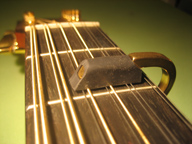 |
13- Slipped Through My Hand (H. Reid) |
This piece has a long history– it started as an instrumental when I needed a 12-string piece for my first LP in 1982 and I recorded a version that was pretty much the guitar breaks to a song I had written. I re-recorded it in 1983 with vocals and a viola on my 2nd LP, then re-did this version in 1989 with my new Taylor 12-string, and even releaed a live vocal version from 1985 on a compilation. It’s just standard tuning down 3 frets with the capo forming an A chord. The thing that makes it work is a tricky right-hand thing I do where I play a Scruggs roll with 3 fingers against an alternating bass on the thumb. (1987 Taylor maple jumbo) [FIngerpicks] |
1989 |
Standard tuning-3 |
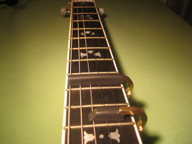 |
14- The Lucky Penny (H. Reid) |
I have done quite of bit of “faux-frailing” over the years, both on guitar and 6-string banjo. I wrote this piece for the Fruit on the Vine CD and it has been out of print for a while, though quite a number of my other pseudo-frailing pieces are around. It’s unusual in that it is in jig time. I do this right-hand thing with 3 fingerpicks and a bare thumb. You could do this on guitar, but the high notes really pop on the banjo, and I doubt it would work very well on guitar. [FIngerpicks w/ bare thumb] (1987 Deering custom Maple Blossom MB6) |
1998 |
Standard tuning |
 |
15- Red in the Sky, Blood on the Water (H. Reid) |
This is one of my favorite Esus pieces, and I play it often. I wrote it on Thanksgiving Day in about 1993, and though the original version (from Circles) and the live version from 1996 are fine, I like the way I play it now, and it sounds a lot richer to my ears than those versions. It pleads again the case that the partial capo should be of interest to classical guitar people. You get the counterpoint, but you also get that warm sustain and ringing drone effect underneath it. [Bare finger/nails] (2004 Dana Bourgeois JOMC cocobolo) Buy the Transcription/TAB |
2010 |
Standard tuning-1 |
 |
16- Sly Damsel Serenade (H. Reid) |
This is a younger brother to the Albatross, 29 years younger. You tune to Eb minor, capo to E major, and then play in Em. If you tune to a minor tuning you really miss having major chords, which I can get anywhere I put the slide. [Bare finger/nails] (2000 Chrysalis Damsel) |
2009 |
Open Eb
Eb Bb Eb G Bb Eb |
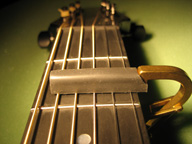 |
17- Camptown Races/ O Susannah (Foster) |
This was remastered from the Steel Drivin’ Man project from 1991. I keep meaning to work up more stuff in this wonderful tuning. You drop the A string 2 frets to G and then capo the top 5 strings. You get a choice of 2 big bass notes under the C chord this way when you play in G position. [FIngerpicks] (1987 Taylor maple jumbo) |
1992 |
Standard tuning-3, with A string dropped 2 more to Eb |
 |
18- Prelude: From the Minstrel’s Dream (H. Reid) |
This is a 1990 re-recording of just the first section of a 23-minute Esus piece of mine called the Minstrel’s Dream. It’s probably my best counterpoint piece ever, and I wanted it to be in this collection, even though it is not hugely different in style and mood from track 2 or track 15. I have tuned down a half-step since about 1985, since I like to sing in Eb and I like the slighly darker sound. [Bare finger/nails] (1990 Taylor 810 custom cutaway) Buy the Transcription/TAB |
1990 |
Standard tuning-1 |
 H
H













